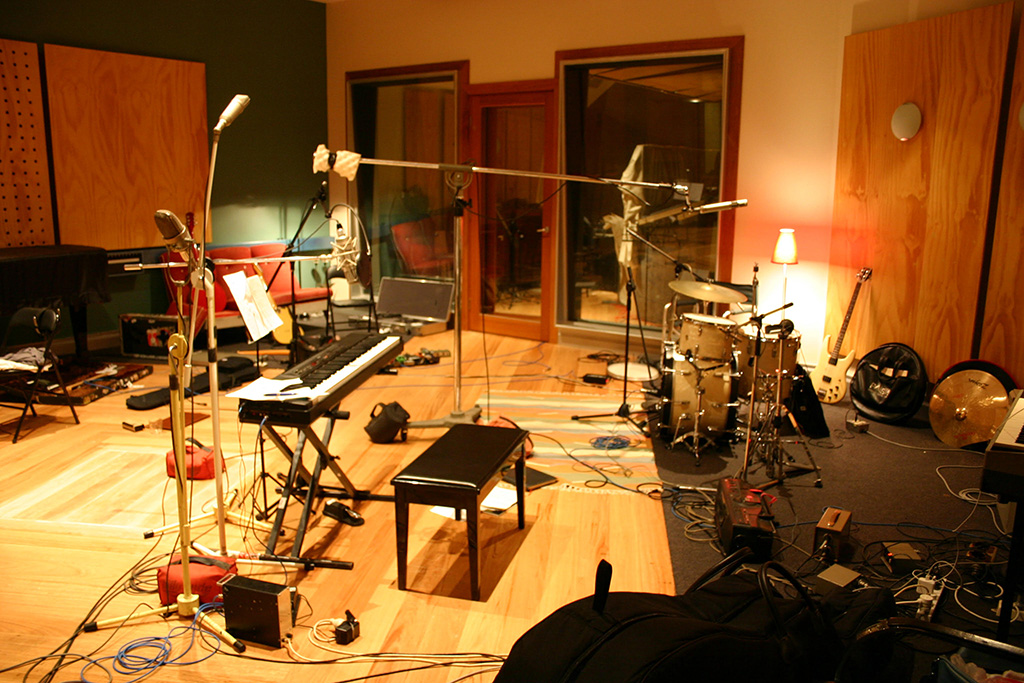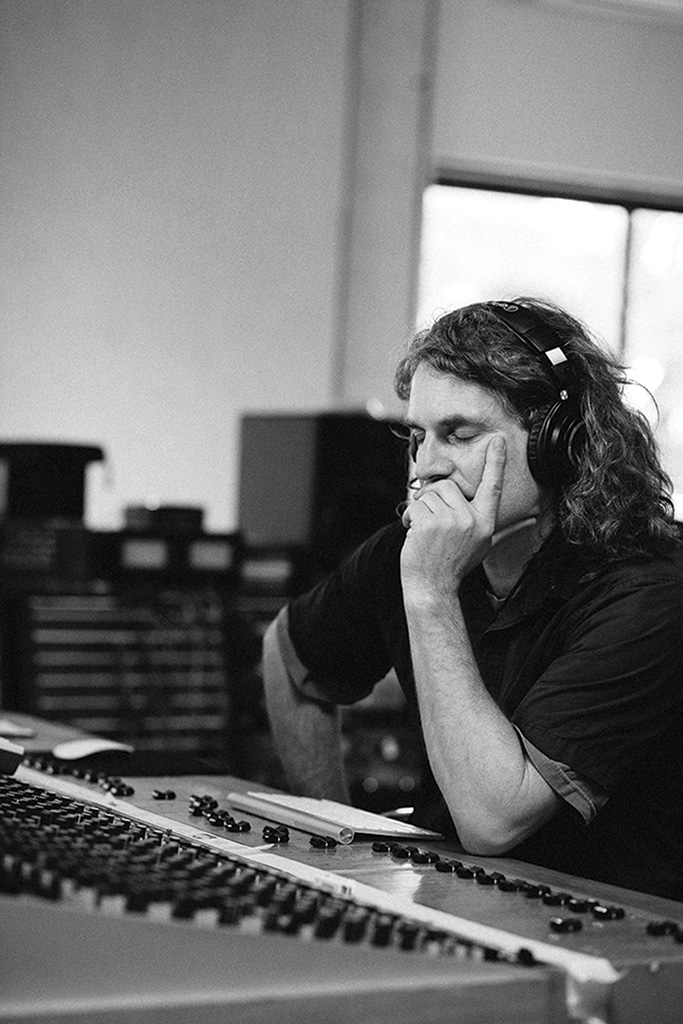Listen Here
27 Sep 2022
Listen Here: Channel Nine & Three Quarters

Subscribe to CX E-News
Is a music production really just the sum-total of its individual audio channels? Or should we be reconsidering the magical space between those channels – the ‘human crosstalk’ of musical interaction? When we track everything as a series of individual overdubs we’re missing out on a huge aspect of musical performance: the complex, subtle interplay that exists between musicians. Or do we ascribe no value any more to this musical exchange? We need to talk…
Some of the producers and engineers I know seem more concerned with phase relationships between microphones than they are with musical relationship between players! Maybe it’s because we can analyse phase; even run a tape measure out to mics if necessary… but how do we quantify the complex human relationships between musicians? Basically, we can’t… and consequently, don’t.
But having no scale of measure for it, separate tracks on which to record it, nor the ability to quantify how much is present in a room at any given time, doesn’t mean the magical mojo (or vibe) between players doesn’t exist, or worse, has no value. On the contrary; live recordings of multiple musicians can bring a song to life in ways that a series of individual overdubs can never hope to replicate. Whether or not we care about this mojo’s absence from a recording, or perhaps more importantly, can hear the difference, is the real issue at play here.
If we like the way a song sounds when it comes together one bolt at a time, then fine; I guess live performances don’t really matter in that circumstance. But I would asset that ‘live takes’ (with two or more musicians) can add an unquantifiable X-factor to almost any production, irrespective of its style or genre. Saying that it’s not relevant to a production without even trying it is often just a veiled attempt to deflect focus away from another issue like, for example, that the studio lacks a decent recording space, or the band has never played well together!
Like dark matter, the physical space between performing musicians is an invisible gravitational force that binds music together. When we capture it well, it’s a magical thing. For the players involved, live performances in the studio are often far more exciting, gratifying and memorable than sitting in a booth playing along to a click track ever was. In part, this is what you capture in the room when a group of musicians perform together; not just sound waves, but their own memories of the event.
Home Suite Home
Probably the greatest loss ever inflicted upon music in the last 30 years was the demise of the large commercial recording studio. Although the ability of a band to track a live performance in a purpose-built space was expensive and came with its own list of limitations, not least of which was money, at least it was an option at one’s disposal back then. And it counted for something… in many cases, crucially.
Meanwhile, in the home recording epoch we live in today, live performances have mostly been replaced by overdubbing, in some cases endless amounts of it. That’s not to say there wasn’t plenty of overdubbing in the past, or that no-one tracks as a live band anymore. Obviously, that still happens; just not anywhere near as often as it did in the past.
Why it happens is the real question. People assert it’s because live performances always involved too many compromises: imperfect takes, too much crosstalk between microphones, not enough time to record the one great take, etc. And of course, all of that is true… still is. But the real issues at play now are more about the fundamental lack of space, the cost of building a studio that’s quiet, and the dearth of recording equipment sufficient to capture a room full of acoustic and electric instruments. That’s what has killed off the live take.
But if you think I’m here to preach for the return of the commercial studio, replete with all its accoutrement, smoke and mirrors, you’d be wrong. I’m merely trying to remind everyone that live studio recording, even if it’s just two people in the room, can add an edge to the music you’re producing that no gear, plug-in, mix wizardry or editing can ever match. When you’re not capturing the aural effects of this dark matter that exists between musicians, you’re simply rendering one track at a time and foregoing everything that might have otherwise existed, or been sparked into life, by the live interplay between musicians. An opportunity wasted in many cases…
And the losses are incalculable in so many respects. Not only does the loss relate directly to how the music is performed, but also how it’s arranged and developed in the first place.
Now of course, I’m not trying to lobby for everything to be recorded like it was back in the ’60s and ’70s, or to claim that every style of music or every individual’s musical circumstance should be thrown into question. Not at all.
But neither is it cool to argue that the ad-hoc arrangement style, individual overdubs and the ‘develop-the-music-one-overdub-at-a-time’ philosophy is always better. When producers or engineers try to run the argument past me that performing a song live in the studio only adds technical headaches to the equation, that’s when I arc up. To say that live takes are anachronistic, too hard, or merely a quaint approach to recording, is rubbish, mostly asserted by people who don’t know any better.
The New Model
But anyway, here we are… at home, looking at the all-too-familiar walls. Most of us are recording in our own spaces now whether we’re happy with this arrangement or not, and indeed, whole generations of musicians have known no other way. Moreover, the approach has countless positive benefits I can’t begin to list here that make recording in a professional studio seem like a gigantic waste of money.
But ponder this for a moment. Like the recent shift from working in an office to working from home that so many experienced recently, there’s a reason why musicians moved to home recording, and it wasn’t just about revolutionary new technology or saving money. On the contrary, it was about spending it, in some cases far more than what it might have cost to enjoy countless sessions in the big studio down the road.
When enough companies realised they could sell every single musician a microphone instead of having them pay good money to stand in front of one in a commercial studio, it was all over for the big recording spaces. Like the planet-killing asteroid that wiped out the dinosaurs, the large studio was made extinct by the thousands of individuals who bought their own gear, turned their houses into studios, their partners into receptionists (whether they liked it or not), and their musical passion into a low-paid recording career. And did they save money? In many cases they spent 10 times more… (and I should know. I’m one of them!)
From that moment on almost no-one who sold professional studio equipment wanted to promote the idea that recording as a band in a big, quiet studio was cool, because the recording space was the one thing they couldn’t sell you. They wanted everyone to buy their own setup for the obvious fact that it would grow their market a thousand-fold. Why try to sell 400 expensive microphones to studios when you can sell 400,000 to individuals?
The world of recorded music is the home studio now, with very few exceptions… even for some of the biggest acts in the world. Every company that sells you stuff tries to convince you that everything they sell and everything you own now is better (and 100 times cheaper) than anything that existed 30 years ago. And hey, in many respects that’s true, apart from one: none of them can sell you a big, quiet space where you and your friends, or the band you’re working with, can have a memorable night where you knock four songs right out of the park. It’s a luxury that most of us can no longer afford, which is a pity.
I have an (unproven) theory about this that links the world of endless overdubbing back to the live take: that people who do endless overdubs in the pursuit of the right song arrangement are often seeking out the dark matter of live performances without even realising it.
Particularly when a song is born in the studio out of thin air and the arrangement doesn’t yet exist, the tendency is for the production of that song to begin almost immediately, regardless.
Rather than develop the arrangement first (assuming that’s appropriate) there’s an immediate impulse to start tracking the first things that spring to mind. And hey, there’s nothing wrong with that impulse, per se – I do it myself all the time. But there’s occasionally a severe downside to this methodology, and it’s this…
You record the first impulse and it seems cool, exciting in fact. From there we’re onto the next thing that springs to mind, and then the next… and so on. Eventually however, though not always, we find ourselves trapped in a maze of overdubs, none of which are necessarily great for the song, and many of which don’t sit particularly well together. The next endeavour is to dive deep into editing, cutting parts, rearranging the performances and cutting up countless takes on playlists. Lots of time can be soaked up diving down this rabbit hole, sometimes for no great outcome.
Is this necessarily the best approach? Sometimes it is, sure. In many cases there’s no other option. But if you spend days, weeks or months working like this, who’s paying for it? You? I thought computers were supposed to make things faster, cheaper and better? Hmm…
So maybe now, in an ironic twist of fate, we’ve spent far too long on the song, we’re no closer to knowing what the arrangement is or how the song should best come together. We’ve overdubbed ‘til we’re square-eyed… and yet somehow we remain convinced it’s the only way.
Sounds like it might have been quicker (and in some cases cheaper too) to develop the song’s arrangement with some like-minded mates, and record the song live… as a band.
Just saying…

Andy Stewart owns and operates The Mill studio in Victoria, a world-class production, mixing and mastering facility. He’s happy to respond to any pleas for pro audio help… contact him at: andy@themill.net.au or visit: www.themillstudio.com.au
Subscribe
Published monthly since 1991, our famous AV industry magazine is free for download or pay for print. Subscribers also receive CX News, our free weekly email with the latest industry news and jobs.




